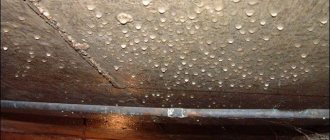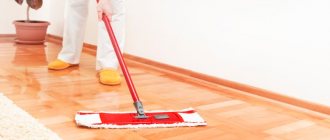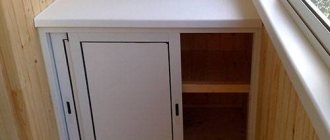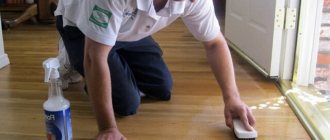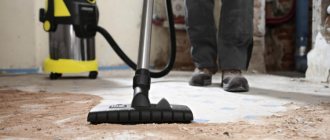- How to get rid of fungus on walls
- How to get rid of fungus under wallpaper
- How to get rid of fungus in the house
- How to dry an apartment after a flood
- How to remove efflorescence from walls
- We will destroy mold on the walls
- How to remove fungus in a wooden house
- Residual moisture measurement
For many, flooding is a nightmare that no one would like to experience.
However, this problem is not that uncommon. It can affect anyone, regardless of where he lives - in a new building, an old “Khrushchev” or in a private house. Prompt communication with the dispatcher
A flood can happen for various reasons. The main ones:
- Burst of water supply, heating, sewerage or water heated floor pipes. These are the most problematic situations, since because of this the apartment or house quickly floods with water, you need to act as soon as possible. At the same time, everything gets wet: the floor, walls, furniture, so it is necessary to dry the room.
- Bay due to neighbors above. Anyone who has ever encountered such a situation knows that there is little pleasant here. Even if there is no water gushing out of your pipes, your apartment can get very wet. First of all, of course, the ceiling and walls suffer. Water flows down the risers, seeps into the seams of the floor slabs and down the walls. The result is a wet wall covering, a damp ceiling and plaster, and a wet floor.
- Precipitation. Heavy rain and snowfall can cause increased humidity in the room. If the roof of a private house or high-rise building is poorly waterproofed, water from the street will penetrate inside. As a result, the walls become wet and the percentage of humidity in the room increases.
- The work of firefighters. The consequences of a fire are not only property destroyed by fire, but also serious flooding during rescue operations. If a fire occurs in an apartment building, then not only the apartment in which the fire occurred suffers, but also the neighboring ones.
- Other reasons for increased humidity.
Regardless of the reason for the flooding, the affected premises must be dried.
Consequences of the flood
The main problem that residents of a flooded apartment will face is standing water. If you look at the root of the problem, then all the difficulties are connected precisely with water, which needs to be eliminated. The longer the water is in the room, the larger the lesion, the greater the number of surfaces and furniture will be irrevocably damaged. The most common consequences of apartment flooding include:
- Moisture permeates the walls, ceiling and furniture, and, contrary to expectations, it is not only the floor that suffers.
- Flooring is something that needs to be completely replaced. If you can still try to save the decoration of the walls and ceiling, then the floor, in most cases, is irretrievably lost. The exception is concrete floors and tiles in case of rapid water removal.
- Flooding of electrical wiring is the most dangerous phenomenon during a flood. The consequences can affect not only the affected apartment, but also the surrounding apartments along the riser and even along the entrance.
- For a long time after flooding, the smell of dampness persists in the apartment, which is almost impossible to remove until the root cause is eliminated and the furniture dries out.
- It happens that flooded finishing materials during the drying process may seem practically undamaged. Be careful with the decision to leave the finish the same, such self-deception can lead to the development and spread of mold in a short time.
Overview of drying methods
1. Candle, alcohol burner, dry alcohol.
The simplest option is a burning candle. It is placed in a metal can directly under the exhaust ventilation pipe. For this purpose, the pipe is expanded with an additional element made of tin, or left open. Drying occurs not due to heating, but due to the fact that the flame creates intense draft and accelerates the replacement of air. The process continues for several days until the dampness is completely eliminated. The duration depends on the humidity level; the method is not suitable for a cellar under a garage.
The candle is replaced with an alcohol burner or dry alcohol tablets, which is not only a good drying agent, but also disinfects. To treat the underground of a private home, 10-15 tablets are usually required. Sometimes the flame from a candle is not enough to quickly begin intense air movement. In this case, first carefully insert a piece of burning newspaper into the ventilation pipe so as not to melt it.
This method can be used in any room except those located under the garage and those with wooden floors or finishing made of flammable materials. The roasting pan is made from an old metal bucket. Many holes are cut in its bottom and walls with an ax. Legs 10-15 cm high are welded from below, and a hook with a cable or wire is attached to the top.
In a prepared brazier located outside the basement, charcoal or linden or birch logs are poured almost to the top and lit with a torch or fireplace lighter fluid. Then, on a cable, a container with burning fuel is lowered into the underground and placed in the center so that the smoke is evenly distributed and freely exits into the ventilation pipe. The method allows you to not only quickly remove unpleasant odors, dry the cellar, but also disinfect it. The combustion is maintained for at least 10-12 hours, opening the lid every half hour to let in a portion of oxygen. Place a fan on the supply pipe or turn on a vacuum cleaner.
During processing, going underground is strictly prohibited due to the high temperature inside and the likelihood of the presence of carbon monoxide. If the coals go out, then the brazier needs to be pulled out using a cable and re-lit. After drying is complete, remove the bucket of coals and close the hatch or door. Do not look into the basement for two to three days. The smoke will destroy fungus and mold. Instead of charcoal, it is permissible to use stone or coke, but maintaining their combustion is more difficult; you can replace the brazier with kerosene gas.
The fuel for the portable potbelly stove is wood. The pipe from it is led directly to the exhaust hole and the door or hatch is opened. The room is heated for 3-4 days. Air drying is carried out due to its intensive circulation and thermal radiation from the walls of the stove. The disadvantage of this method is that it poses a fire hazard; if it is located under a garage or if the ventilation pipe is made of plastic, then the potbelly stove cannot be used.
Actions in case of flooding
Let's return to the question of how to dry an apartment after a flood. The situation requires specific actions in case of flooding, which it is advisable to carry out without delay.
- First of all, turn off the power to the apartment to avoid short circuits and injuries, remember safety: water is a conductor of electric current. A professional electrician will help you with the next steps: either the wiring will work after drying, or repairs will be required.
- Place carpets, textiles and furniture in a ventilated area until completely dry. If outdoor placement is possible, take advantage of it.
- Eliminating the consequences of ceiling flooding depends on the finishing method. Plastic or wooden panels will have to be dismantled, but do not rush with suspended ceilings: there is a chance that after the water is drained and the ceiling is dried, the consequences of the flood will not be noticeable.
- Flooding of walls has greater consequences than the situation with the ceiling. Wallpaper, chipboard and drywall will have to be dismantled; if mineral wool is used as insulation, it will need to be replaced. Treat all surfaces with an antifungal agent: purchase a special solution at a hardware store.
- Floor flooding is the most common problem during a flood, as water lingers and floor finishing materials are in contact with moisture longer than others. Laminate, linoleum on a soft base - these materials will not tolerate contact with water and will have to be replaced. Try to dry ordinary linoleum face down; the parquet is subject to partial dismantling and replacement of damaged boards.
- After physically removing water from the room, use dehumidifiers to speed up the drying process. With them, the apartments will dry in 1.5-2 weeks, without them it will take at least 1.5-2 months, and, as I already said, the time the materials are exposed to moisture increases losses.
Preparation and initial drying
1. It is more convenient to carry out the procedure in the summer, when most of the shelves are empty. All boxes, drawers, and racks are dismantled and taken out into the fresh air for ventilation.
2. Open the door or hatch to the cellar and leave for two to three days (subject to dry weather). Fresh air will partially reduce the humidity. If the process takes a long time, then the ventilation requires cleaning.
3. If heavy, humid air has difficulty rising through the exhaust pipe, then it is necessary to stimulate the initial natural draft. To do this, a lit torch made of thick paper is briefly brought to the exhaust pipe.
4. If the humidity is very high, then bring in a box with some kind of natural desiccant - charcoal or dry lime; they absorb moisture from the air well.
5. Fumigate the room with a special sulfur smoke bomb. This will help destroy mold, bacteria, insects and repel rodents. Sulfur is very dangerous to human health, so when carrying out processing it is important to strictly follow all precautions.
6. Clean the walls from plaque and debris.
7. Treat all surfaces with a concentrated solution of potassium permanganate.
8. If the floor is earthen, then remove the top layer of soil and replace it with dry, clean sand.
Cover the basement walls of a private house with thick whitewash made of lime with a 5 or 10% solution of copper sulfate. Carry out the procedure wearing protective clothing, goggles and gloves. Using a special whitewash paint brush, similar to a broom, lime is sprayed onto the walls. A day after applying the first layer, apply the second and wait until it dries before proceeding to the main drying stage.
Processing of wooden racks and boxes removed from the cellar:
- It is recommended to leave boxes, crates and other wooden fixtures in bright sunlight for a while. Ultraviolet light effectively fights moisture, mildew and mold. Very crude structures are burned with a blowtorch.
- Wash all parts with soapy water and baking soda. Treat surfaces with formaldehyde. To enhance the effect, it is mixed with copper sulfate.
- Dry drawers and shelves. Prepare whitewash from a bucket of lime and 100 g of 5% copper sulfate solution and cover all wooden surfaces with it.
You can bring racks and drawers back into the cellar only after the process is completely completed.
Paper questions
Flooding of an apartment entails large financial losses. There are several ways to reduce costs:
- If you detect flooding in an apartment, call the emergency service, which is required to draw up a report that lists the affected objects, and also notes that furniture, decoration and systems were damaged as a result of flooding.
- Take photographs or video of the consequences of the flooding; this evidence may be useful to you in court.
- Before going to court, try to resolve the issue amicably. Remember that the upstairs neighbors are not always to blame for the flood. The culprit may be neighbors several floors above, as well as the management company.
- Consider flood insurance for your home. Insurance will not save you from possible floods and troubles, but it will help reduce financial losses.
I hope my article will help you quickly and effectively cope with the consequences of a flood, if such an unpleasant incident does occur in your family.
Become our author
Every person is special, and everyone's experience is unique. Tell us about yours. Earn recognition and gratitude from our readers.
Flooding of an apartment, private house or office is an unpleasant and unexpected situation. Initially, you need to understand who is to blame for this situation.
If you are the culprit of the flood, the best option is to reach an amicable agreement with your neighbors, take a receipt stating who is receiving assistance, in what amount, for what, and most importantly, that the victim has no further claims other than one-time assistance. If it’s all the fault of the housing office, then the first thing you need to do is call their representative to draw up an act on the flooding of the apartment. It will indicate all the necessary information (date of flooding and drawing up of the report, names and positions of the persons who draw up the report, list of damaged items, description and estimated cost of damage caused by the flooding). Afterwards, you can write a statement of claim for trial.
But then we need to quickly solve the problem itself...
Consequences after flooding an apartment or house
What does unexpected flooding or flooding due to burst water pipes bring?
- Damage to wallpaper, peeling of plaster, paint, whitewash.
- Stains on the ceiling, damage to the ceiling finish.
- Water seeping under the linoleum, wetting the substrate and base.
- Absorption of water into concrete floors and wooden bases.
- Swelling of parquet, formation of bumps and cracks, blackening of parquet boards.
- Swelling of laminate slabs, peeling of the surface layer and the formation of uneven floors.
- Damage and corrosion of contacts of electrical sockets and switches, risk of short circuit.
How do you dry the walls?
After arriving at the site, specialists first assess the situation. To speed up this process, you can send us photos via WhatsApp in advance. After this, the drying technology is selected. All work is carried out with control of the level of residual moisture. This is necessary to prevent overdrying. The drying process uses specialized high-end drying equipment. It draws moisture from any surfaces and materials and removes it beyond the drying circuit.
At the same time, the equipment does not emit heat or dust, and does not make noise. During drainage work, you can remain at home without feeling any discomfort. The speed of work depends on the degree of damage. Most often, it takes several days to eliminate the consequences of a flood.
To dry the rooms, we do not need to dismantle the wall coverings. The work is carried out gradually: from the wettest areas to the drier ones. Drying can be done in any room. Drying equipment allows you to work even in hard-to-reach places (for example, risers, behind drywall).
Professional drying is the fastest and most effective way to remove moisture from walls.
What to do first
First of all, ensure safety in the apartment and turn off the electricity, then call the emergency service. While the emergency service is on the way, experts recommend filming the consequences and traces of the flood to make it easier to compensate for losses in the future. After this, you can begin to save things and eliminate the flood. Then record the consequences again using photos or videos.
After a flood, it is important to determine the cause in order to quickly fix the leak and determine who is to blame. It's not necessarily the neighbors' fault. If, for example, a pipe or a common riser bursts, the management company or housing office is responsible. Flooding due to the fault of housing and communal services occurs if the roof is leaking, if utility services have not properly cleared snow or replaced pipes in the house.
Invite your neighbors to your apartment to document the fact of the flood and the damage. Find out who lives in the upper apartment that caused the accident.
Then, together with the emergency service employees, you need to write a report that will document the incident. To draw up a report, the presence of the affected owners and neighbors, those responsible for the flooding, representatives of the management company or housing office (emergency service), as well as witnesses is necessary.
How to dry the subfloor (basement) in a house?
October 13, 2013. Read 23604 times
When you make repairs, of course, you want it to be of high quality, good, and durable. After all, who wants, for example, to carry out repair work again in a year? I think no one. Why am I asking this?
Crazy Stroitel.ru will tell you how to dry the underground floor in your house. You may ask, why do I need this? And what difference does it make how to dry this underground? After all, they will put a floor on it, and everything will be fine. But here you are wrong. It's no secret that everything starts with the basics. Everyone knows that the earth that is under the floor is an eternal source of moisture. Which leads to dampness and an unpleasant rotten smell. This is why it is so important to know how to dry the underground in your home. After all, no one wants to be in a room where it’s humid and damp, and what’s more, there’s a terrible smell? Read now how to dry the underground floor in your house
and this problem will bypass you. And your home will always be cozy, warm and comfortable. How does excess moisture enter our homes?
1. So, if you do not have a good quality foundation, then water will enter through cracks in the foundation. If this is the case, then be sure to find out how to dry out the underground in your house and do a good job.
2.In spring and autumn, when the groundwater level is so high, water is absorbed under your floor. And lastly, moist and warm air gets under the floor. And that’s why condensation occurs in our house, or rather, dew drops appear on the walls of the room.
Several ways to dry the subfloor (basement) in your house
The first mechanism is sealing
1. The first thing you need to do is seal the interior walls of the foundation. What does it mean? And the fact is that you will need to additionally concrete or glue the foundation and walls of the underground with a special reinforced film or rubyroid. True, there are some difficulties in doing such work. This is sealing the film joints at the corners.
2. To keep the underground in our house dry, the second thing we do is seal the joints using special mastics and sealants.
3. It is necessary to secure the upper part of the film to the underground walls using dowels.
4. After this, apply an additional ball of concrete onto the film. This is necessary to protect the material from mechanical damage.
Advice: if the concrete will not adhere at all to large underground walls, then line them around the perimeter with plastic sheets or bricks in one row. This is just the first way to dry the subfloor in your house.
How to draw up an act
The act indicates the reasons for the flooding and the place where it occurred, and a list of damaged property. The list includes the area of the living space, a detailed description of the walls, floors and ceilings, indicating the dimensions and finishing material. We also indicate other damaged property, which may include household and electronic appliances, clothing and personal items.
It is important to indicate that the property was damaged due to flooding. The act is accompanied by evidence in the form of photographs and videos, which is important to take before taking measures to dry the apartment and eliminate the consequences. The application is signed by those present.
Try to negotiate with your neighbors about compensation for the damage. If you cannot reach an agreement, you will have to turn to the magistrate. In this case, an independent examination is often performed, during which an assessment of the damage to the apartment is made. It is also recommended to contact the courts if the same neighbor’s apartment floods systematically.
How to effectively dry the walls and floors of your home?
Of course, the first thing you should do is pump out the excess water and then remove all damp furniture, furnishings and carpets from inside the house. In extreme cases, if there has been extensive flooding of the walls, it will also be necessary to remove the plaster from the walls.
There are two different ways to keep your home dry after a flood:
- natural;
- mechanical.
Let's look at their features in more detail.
How to properly drain a house naturally after a flood?
This method assumes that you will not use any devices to remove excess water and moisture from your home. Of course, today there is a lot of equipment and solutions that allow you to effectively pump out water and dry a house, but they can sometimes ruin the repairs made or damage some elements of the house’s structure. Therefore, it is better to first try to dry the house naturally.
The first step in naturally drying your home is to open all doors and windows. Thanks to intensive natural ventilation from the street, excess moisture will leave the house without any mechanical intervention. However, the disadvantage of this solution is the long drying time. You will have to wait at least several hours until the flooded rooms dry out due to the influx of fresh air. So this method is mainly suitable for small cottages and houses that have been partially flooded.
On the contrary, it will most likely not be possible to dry large houses in this natural way. And this is not only due to the larger area and, as a rule, a huge amount of water - both in the walls and in the ground on which the house is being built - but also because of the weather. This method is useless if it is very humid outside or if it is raining or, worse, snowing.
In winter, it is more difficult to dry the house, not only because of the snow and low temperatures, but because of the need to heat the house. Obviously, it won’t be possible to heat it with the windows open, and besides, heating a flooded house can cause the paint and plaster to peel off, and all the wooden floors and walls to “swell” and even begin to collapse.
For such complex cases of drying a house, it is no longer possible to do without mechanical means, in particular powerful fans that will create air flows in the right direction. And here we smoothly move on to mechanical means of draining houses.
What means and equipment can be used to dry a house after a flood?
As a rule, any equipment is designed to enhance and speed up the natural drying of the house. The first thing you should pay attention to is any heaters and radiators used as a supplement to regular domestic heating. If you have portable radiators in your home, simply move them to the water-damaged wall and turn them on at full power.
To dry your home faster, you can use any type of heater: electric, gas or oil. It is important to constantly monitor the operation of the radiator, because you turn it on at full power in a water-damaged house; if you do not monitor the heater in such a situation, it can damage the surface and even lead to a fire.
In addition to portable heaters, any fans will also come in handy. The more powerful they are, the better. If your home is equipped with a supply and exhaust ventilation system, turn it on at full power. But, before that, be sure to check if it is flooded. If the vent is flooded, you must first remove all water from it and wipe it dry, otherwise this may lead to a short circuit in the wiring.
Air dryers
This is specially designed equipment that is more powerful and effective in combating excess humidity in homes and premises, compared to traditional heaters and fans. How do such devices quickly dry the air? They are designed with a mechanism that turns water droplets in the air into plain water, which is then sent to separate reservoirs.
By purchasing a dehumidifier, you can significantly speed up the process of drying out your home after a flood. For larger houses and also in case of large floods, the use of industrial dehumidifiers is recommended. Only they can cope with such excess water.
These devices very quickly remove moisture and condensation from walls and other surfaces. However, they have 2 disadvantages:
- high price;
- high power consumption.
Although, of course, there are inexpensive solutions. It all depends on the power of the device. According to this parameter they are divided into:
- condensation dehumidifiers;
- absorption dehumidifiers;
- industrial dehumidifiers.
For apartments, dachas, townhouses and small houses, purchasing equipment of the first two types will be sufficient. For large cottages and mansions, as we noted above, it is better to purchase industrial dehumidifiers.
To check the moisture status of walls, floors and ceilings, builders often use a special device, a hygrometer. It allows you to quickly find even hidden leaks and flooded elements inside the house.
The operation of all the equipment described above will only make sense if the house has effective ventilation. Using a dehumidifier, fans, and other “boosts” for each building element looks different. So, let's take a closer look at drying methods for specific surfaces.
Who is guilty
If the flooding occurred due to negligence (forgot to turn off the water) or due to a breakdown of the plumbing or faucet, appliances (washing machine, dishwasher, etc.) and other devices located in the owner’s apartment, the owner is to blame.
If the apartment is rented, the tenants are responsible for flooding due to negligence. If, due to a breakdown of plumbing and other devices inside the apartment, the owner of the property, since he must ensure that communications inside the living space are in good condition.
Moreover, the complaint is sent to the owner of the apartment, and he must compensate for the damage. And only then the owner, if necessary, seeks compensation for damage from the tenants.
The management company and the housing office are responsible for the equipment and heating system, including in the apartment, for shut-off devices and equipment up to the first control valve, for water supply risers and a number of utilities. If a pipe or heating battery bursts, if the riser breaks or the roof leaks, the housing and communal services authorities are to blame.
How to dry the wall of a house on your own?
Of course, completely different actions will be performed for internal and external walls. In particular, for drying walls inside the house, the order will be as follows:
- The first step is to remove all water-damaged elements from the wall - wallpaper, wall panels, tiles, etc. If the wall is very flooded, you will have to remove the plaster - both at the site of flooding and about 0.5 meters above it;
- Next, you should begin cleaning the walls and disinfecting them;
- Once all the moisture has dried, you can reapply the plaster and begin finishing.
Drying exterior walls will be a little more challenging:
- If your house has a layered wall structure, check if there is water in the subsequent layers? How? Simply drill a hole above the base of the wall. If water appears, you will have to make holes across the entire width of the wall at intervals of approximately 1 meter;
- Then, as with interior walls, the plaster should be scraped off;
- The next step is to clean and disinfect the walls;
- If your home's insulation has been severely flooded, we will have to replace it. Of course, this will be quite expensive, so if you don't have the budget to replace the insulation, you could try simply drying it out, then cleaning and disinfecting it.
How to insure an apartment against flooding
Many residents prefer to insure their property and living space, including against flooding. Insurance will not save you from an unexpected flood in your apartment, but it will help cover damage and pay for repairs. However, even here it is not possible to receive compensation in every case; it is important to carefully study the contract.
The terms of the contract must include an independent assessment of damage due to flooding of the apartment. In this case, not only the living space, but also the things inside must be insured. A mandatory clause in the insurance is an indication of the reasons for the flooding for which the damage will be paid. Experts recommend indicating flooding due to both the fault of neighbors and the fault of utility services. Please also pay attention to the amount of compensation.
If the above conditions are met, you will be able to receive monetary compensation and cover repairs. Let's figure out what to do if the neighbors above flooded the insured apartment. If the apartment is insured and the living space is flooded, the following procedure must be followed:
- Call emergency services;
- Take photographs or video of the consequences of the accident;
- Draw up a report indicating the damage;
- Write an application to the insurance company providing the report, insurance contract and evidence of damage (photo or video).
After this, the insurance company can conduct an additional examination and then pay for the damage. If you have already started repairs, along with the report, provide “before” and “after” photographs, checks or receipts for payment for services, construction and finishing materials. Be sure to save receipts if you have already started major repairs or carried out any procedures and have not yet compensated for the damage.
How to eliminate the consequences of a flood
After flooding, the floor and floor covering, ceiling and walls, decoration, furniture and various interior items are severely damaged. Plastic is the least susceptible to negative effects. In addition, the wiring may fail, and there may be a damp smell and mold in the apartment. To avoid serious negative consequences, it is important to dry the premises correctly and thoroughly.
To restore an apartment after a flood, it is not enough to just remove puddles of water; you need to thoroughly dry the room. In addition, it is necessary to treat surfaces with anti-mold agents to avoid the appearance of mold and mildew, the unpleasant smell of dampness and rot in the apartment.
If your neighbors are seriously flooded, be sure to check the electrical wiring and replace it if necessary. After a heavy flood, upholstered and wooden furniture can hardly be dried and restored. In this case, the doors expand, after which they may not close. You will have to slightly trim the door leaf or trim or replace the door completely.
A suspended ceiling that can withstand large volumes of water effectively protects against moisture and flooding. In this case, it will only bend down, and water will not penetrate into the room. After a flood, the suspended ceiling is dismantled and the water is drained, then completely assembled or a new one is laid if it cannot be restored. But it is better to restore one ceiling than all the walls and floors, rather than replacing furniture.
A plasterboard ceiling becomes completely unusable after flooding. If the drywall is only slightly deformed, you need to dry the material, sand it, cover it with a primer and a layer of paint. It is enough to dry a classic whitewashed or painted ceiling for several days, then the surface is primed and covered with a new layer of paint or plaster.
We do the same with painting the walls. If there was wallpaper on the walls, most likely you will have to completely replace the material. If the flooding from the neighbor's apartment was minor, you will only need to glue or re-glue the affected areas. If the water in the apartment has stood for a long time, the wooden floor coverings can be seriously damaged. The material will have to be disassembled and replaced.
Drying out the garage
In order to dry the air in the garage, it is better to use heat guns
: They will get the job done very quickly. Moreover, it is in the garage that you can use not electric devices, which consume a lot of energy, but their gas counterparts, or even diesel heat guns. The latter are considered the most economical, but during operation, as a result of fuel combustion, they produce an unpleasant odor, which is not as critical for a garage as for a living space. Thus, a diesel heat gun with a power of 20 kW consumes about 1 liter of fuel in 1 hour. Depending on the size of the garage and the air humidity in it, the drying time may vary.
If the humidity in the garage is high, you can try using a dehumidifier.
. By the way, some companies provide not only the sale of such devices, but also their rental, which is very convenient: you can dry the garage space in a few days, remove the cause of dampness, and the dehumidifier will not be unnecessarily stored somewhere in the corner.
If it is not possible to use special devices, you can dry the air using heaters and fan heaters
.
And, of course, there must be normal ventilation
to remove moist air, and the presence of heating in it, i.e. recuperator is an additional plus.
How to dry an apartment after a flood
To quickly dry rooms after a flood, you need to open windows and doors to create powerful ventilation and ventilation. If there is a lot of wooden furniture in the house, ventilation should not be left for a long time, otherwise the wood will become deformed. If there is a large volume of water on the floor under laminate, parquet or other covering, you need to remove the material, eliminate the water and dry the floor thoroughly.
The covering material is dried separately and laid again. Damaged laminate and parquet slats are replaced with new ones. Linoleum is more resistant to moisture, so it rarely requires replacement. For more information on how to dry linoleum, parquet and laminate after flooding, see the link https://vsepodomu.ru/uborka/kak-prosushit-linoleum/.
To reliably dry an apartment in a short time, modern dehumidifiers are used. The device is installed in a room with closed windows and turned on at maximum power. After complete drying, it is important to treat the surfaces with anti-mold and mildew compounds. Inspect furniture and household items. If traces of fungus or mold have formed on the products, it is better to get rid of them immediately.
Mold and mildew cause serious harm to health, deteriorate the appearance of the room, fill the room with dampness and unpleasant odor, and reduce the service life of finishing materials.
If you plan to use damaged finishing materials (flooring, wallpaper, etc.), after complete drying, the products are also treated with protective agents. It is important to carry out repairs and finishing only on completely dry surfaces! Be prepared that drying the apartment will take several days.
Drying the room
If the flooding is not severe, you can remove the water yourself using rags and a bucket.
This is a fairly quick process, and any owner can handle it. But what to do if the water level rises to your ankles?
In such situations, time is really short.
Therefore, the water will have to be scooped up with some kind of container and poured into the sewer or onto the street. If you call a specialized team, they will pump out the flooding with powerful pumps and dry the room using an air dehumidifier. Unfortunately, if the interior is very damp, then the problem cannot be dealt with naturally. It will take several days for the moisture to evaporate from the floor. And during this time, the material may swell and become completely unusable.
Special air dehumidification equipment is currently gaining popularity around the world. This is a relatively fast and gentle method that has proven its effectiveness even in the most difficult cases.
If you have a heat gun at home, and the house has good ventilation, then you can do it on your own. The floor will have to be dried by hand in separate sections. This work will take some time, but the effect will be no worse than using a dehumidifier. But under no circumstances use air conditioning, because... it is not designed for such a load!
A heated floor system can also cope with the task, provided that it is not damaged by flooding. We open the windows, turn on the heating and wait for complete ventilation.
